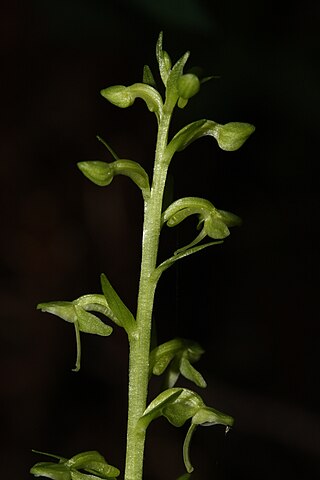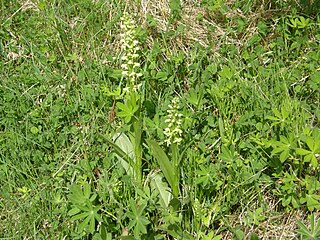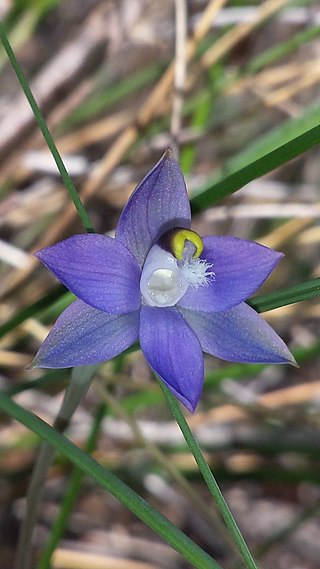
The genus Platanthera belongs to the subfamily Orchidoideae of the family Orchidaceae, and comprises about 150 species of orchids. The members of this genus, known as the butterfly orchids or fringed orchids, were previously included in the genus Orchis, which is a close relative. They are distributed throughout the temperate regions of the Northern Hemisphere. They are terrestrial and have tubercules.

Platanthera blephariglottis, commonly known as the white fringed orchid or white-fringed orchis, is a species of orchid of the genus Platanthera. It is considered to be an endangered species in Connecticut and Ohio, a threatened species in Florida, Maryland and Rhode Island, exploitably vulnerable in New York, and susceptible to be threatened in Québec.

Hammarbya paludosa is a small orchid commonly known as bog orchid, bog adder's-mouth or bog adder's-mouth orchid. It grows in bogs in temperate and subarctic regions of the Northern Hemisphere.

Platanthera psycodes, commonly called lesser purple fringed orchid or small purple-fringed orchid, is a species of orchid, genus Platanthera, occurring from eastern Canada to the east-central and northeastern United States. It is imperiled in Illinois, Tennessee, North Carolina, and Kentucky.

Platanthera sparsiflora is a species of orchid known by the common name sparse-flowered bog orchid. It is native to the forests and meadows of the western United States, and also south to Baja California.

Platanthera stricta is a species of orchid known by the common name slender bog orchid. It is native to western North America from Alaska and Yukon south to Utah and northern California.

Platanthera hyperborea, the northern green orchid, is small orchid found only in Greenland, Iceland, and Akimiski Island in Canada. Numerous authors cite the species as widespread in other parts of Canada and also in the United States; such populations are more correctly referred to as Platanthera aquilonis.

Platanthera obtusata, common name blunt-leaved orchid or small northern bog orchid, is a small species of orchid in the genus Platanthera. It widespread across much of the colder regions of the Northern Hemisphere, though rare in some parts of its range. Two subspecies are recognized:

Isotria verticillata, commonly known as the large whorled pogonia and purple fiveleaf orchid, is an orchid species native to eastern North America.

Platanthera zothecina is a perennial plant in the orchid family (Orchidaceae) found in the Colorado Plateau and Canyonlands region of the southwestern United States and is found in the states of Utah, Arizona and Colorado.
Malaxis wendtii, the Wendt's adder's-mouth orchid, is a North American species of orchids native to northern Mexico and the US State of Texas.

Thelymitra brevifolia, commonly called the peppertop sun orchid or short-leaf sun orchid, is a species of orchid that is endemic to south-eastern Australia. It has a single erect, relatively short and broad, dark green leaf and up to twenty purplish or purplish blue flowers. It is a common and widespread self-pollinating species occurring in a wide range of habitats.

Platanthera dilatata, known as tall white bog orchid, bog candle, or boreal bog orchid is a species of orchid, a flowering plant in the family Orchidaceae, native to North America. It was first formally described in 1813 by Frederick Traugott Pursh as Orchis dilatata.

Juncus marginatus is a species of flowering plant, it is a type of rush with the common names of margined rush and grass-leaf rush.

Platanthera purpurascens, the purple petal bog orchid, is a terrestrial orchid of North America.

Platanthera aquilonis, the northern green orchid or north wind bog orchid, is a species of self-fertilizing orchid native to the United States and Canada with a widespread distribution across the two countries.

Platanthera convallariifolia, the bog orchid, is a species of orchid native to the Aleutian Islands, far east Russia and northern Japan. It grows in wetlands such as fens and marshes.

Coenoemersa limosa, commonly known as Thurber's bog orchid, is a terrestrial orchid of Guatemala, Mexico and the United States.

Platanthera tipuloides, the Aleutian Bog Orchid or Bering Bog Orchid, is a terrestrial orchid native to the United States, Russia, China, Japan and Korea.

Platanthera chorisiana, Chamisso's orchid or Choris' bog orchid, is a terrestrial orchid native to the United States, Canada, Russia and Japan.



















